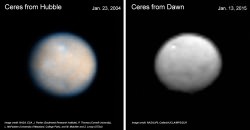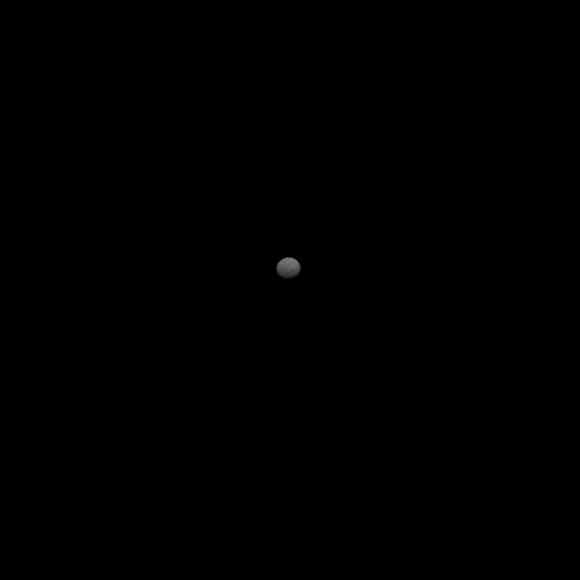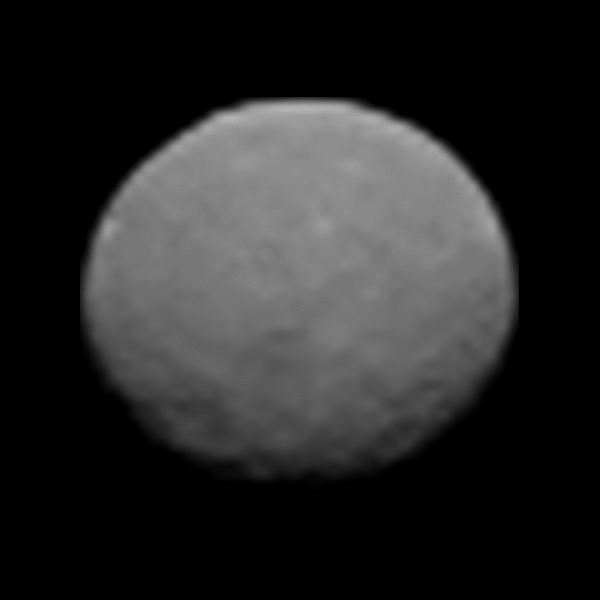This is the second animation from Dawn this year showing Ceres rotating, and at 43 pixels across the images are officially the best ever obtained!
NASA’s Dawn spacecraft is now on final approach to the 950 km (590 mile) dwarf planet Ceres, the largest world in the main asteroid belt and the biggest object in the inner Solar System that has yet to be explored closely. And, based on what one Dawn mission scientist has said, Ceres could very well be called the Solar System’s “hipster planet.”
“Ceres is a ‘planet’ that you’ve probably never heard of,” said Robert Mase, Dawn project manager at NASA’s Jet Propulsion Laboratory in Pasadena, California. “We’re excited to learn all about it with Dawn and share our discoveries with the world.”
Originally classified as a planet, Ceres was later categorized as an asteroid and then reclassified as a dwarf planet in 2006 (controversially along with far-flung Pluto.) Ceres was first observed in 1801 by astronomer Giuseppe Piazzi who named the object after the Roman goddess of agriculture, grain crops, fertility and motherly relationships. (Its orbit would later be calculated by German mathematician Carl Gauss.)
“You may not realize that the word ‘cereal’ comes from the name Ceres,” said Marc Rayman, mission director and chief engineer of the Dawn mission at JPL. “Perhaps you already connected with the dwarf planet at breakfast today.”
Ceres: part of this nutritionally-balanced Solar System!

The animation above was made from images taken by Dawn framing camera on January 25, 2015 from a distance of about 237,000 km (147,000 miles). These are now the highest-resolution views to date of the dwarf planet, 30% more detailed than those obtained by Hubble in January 2004.
And there’s that northern white spot again too… seen in observations from earlier this month and in the 2003-04 HST images, scientists still aren’t quite sure what it is. A crater wall? An exposed ice deposit? Something else entirely? We will soon find out.
“We are already seeing areas and details on Ceres popping out that had not been seen before. For instance, there are several dark features in the southern hemisphere that might be craters within a region that is darker overall,” said Carol Raymond, Dawn deputy principal investigator at JPL.

From now on, every observation of Ceres by Dawn will be the best we’ve ever seen! This new chapter of the spacecraft’s adventure has only just begun.
Dawn is scheduled to arrive at Ceres on March 6. Follow the progress of the Dawn mission here.
Source: NASA/JPL
*(Does this mean that Ceres has now gone “mainstream?” Hmm… oh well, it’s still cool.)


Interesting. It looks smoother than I expected, and that white feature really does look like just a white patch. I was sure that it would be a crater, but there’s no evidence of that at the moment.
Just a WAG, but that white patch sure seems to be convex rather than concave as the obvious craters are. Artifacts of the image processing?
Or would the ice covered ocean that has been hypothesized be venting some sort of gigantic frosty bubble. Inquiring minds want to know.
Both Dawn and New Horizons offer an unique historical opportunity for fun and science in Universetoday. From now, for Ceres, and for Plato, on and after May 5, images will be of a resolution surpassing those taken by Hubble. What will these images look like? Why not run a competition with a dated gallery to find who can best photoshop visual anticipations? Given today’s new pics, what will the next ones look like?
After all, a competition, the Gene Sweepstake, existed between 2000 and 2003, for the number of genes that would be found in the human genome. And running a competition for Ceres and Plato is not frivolous–the failure of biologists to guess correctly the low figure of genes (as it was to turn out) in the human genome was revealing about the limited degree to which biologists understood the factors determining gene number. Here an opportunity exists to learn about the hidden restrictions that exist in our abilities to envisage unseen worlds. Maybe, for example, we are biased to attend to features of certain spatial frequencies more or better than others, or that we get over influenced by science fiction art in certain aspects of our imagination rather than using what we can see in actual images of known planets and moons. Surely better can be done than the imagined photos of Ceres on Nasa’s Dawn page or twitter’s cerestoday? Without a What-will-they-look-like” competition we miss the opportunity to gain data about such biases and so the opportunity to learn how to improve the accuracy of human imagination.
That matters. No human will ever see the real appearance of an exoplanet, this could be the last chance, to get data upon unappreciated biases that might distort the best human attempts to envisage what they actually look like close up.
How much time does this animation cover? How quickly does this object rotate?
Ceres rotates once every nine hours.
What is the White Spot – if not ice?
Ceres is dark, Vesta is much lighter, maybe the White Spot is the result of Ceres being impacted by a small member of the Hirayma family of asteroids. The reverse appears to be the case with Vesta being covered with dark spots. Although there is no definite proof yet, there is a smoking gun which indicates that the White Spot is the result of an impact with a Vesta like object.
Roseland Observatory